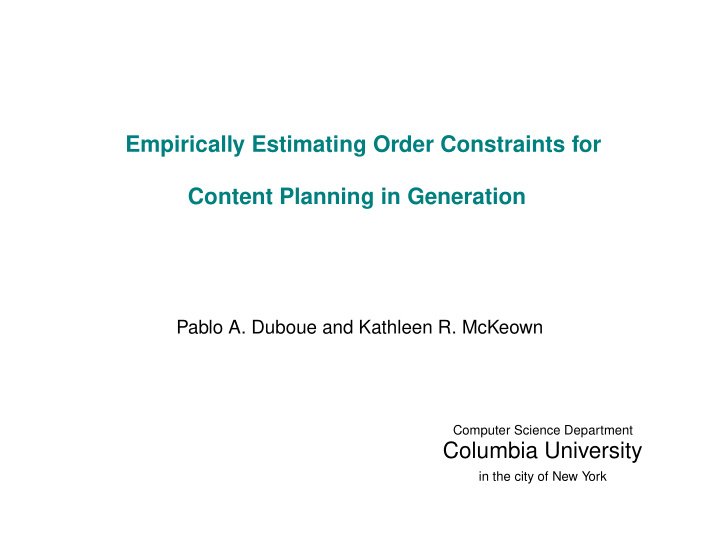



Empirically Estimating Order Constraints for Content Planning in Generation Pablo A. Duboue and Kathleen R. McKeown Computer Science Department Columbia University in the city of New York
� A Natural Language Generation Pipeline Generation Pipeline from (Reiter 1994, Reiter and Dale 2000): 1. Content Planning What to say 2. Sentence Planning Division into sentences 3. Surface Realisation How to say it
� � � Our Task Applying Empirical Methods to Content Planning Content Planning is Deeply Tied to Semantics Learning Backbone Ordering Constraints Important in Practice Dependent only on the Domain Semantics Easily Extendable diabetic patients and past medical history
� � ✁ � Task Specification Input Set of Semantically Tagged Texts Output Elements Sequence of Semantic Tags Global Ordering over Elements Methods Apply Computational Biology over the Sequences of Tags
� � Our System: MAGIC MAGIC Fully Developed Intelligent Multimedia Presentation System Medical Domain Task Reporting Cardiac Surgery Patient Status Time Critical
MAGIC: Example “J. Doe is a seventy-eight year-old male patient of Doctor Smith undergoing aortic valve replacement. His medical history in- cludes allergy to penicillin and congestive heart fail- ure. He is sixty-six kilo- grams and one hundred sixty centimeters. . . . . . . ”
✂✄ ☛ ✟ ✂ ✠ ✡ � ✆ ✁ ✁ ✞ ☛ ☞ ✆ ✞ � ✞✌ ☛ � The Data From the Evaluation Described in (McKeown et al., 2000) Annotated Transcriptions of Physicians Briefings Semantic Annotation Assisted by a Domain Expert Semantically Tagged Non-overlapping Chunks (Clause Level) Tag-set Over 200 tags 29 categories Expensive Task Intensive Care Unit, a Busy Environment Total Number: 24 Transcripts Average Length: 33 tags ( , , ) ☎✝✆
The Data: Example “He is 58-year-old History is significant for Hodgkin’s disease male . , age gender pmh Hyperspadias treated with . . . to his neck, back and chest. , , BPH pmh pmh proliferative lymph edema in his right arm and . No IV’s hiatal hernia pmh pmh or blood pressure down in the left arm. Medications — Inderal , med-preop Lopid Pepcid nitroglycerine heparin , , and . . EKG has PAC’s ekg-preop med-preop med-preop drip-preop med-preop His Echo showed AI, MR of 47 cine amps with hypokinetic basal region. echo-preop , otherwise his labs are unremarkable. Went to OR for what was Hematocrit 1.2 hct-preop felt to be 2 vessel CABG off pump both mammaries . . . . . . ” procedure
� � � Analysis of the Problem Focus on the Sequence of Semantic Tags: Find Regularities in Sequences Biological Sequence Analysis Techniques Similar problems Scalability
� � � � How to Learn Order Constraints Measure the Frequency of Possible Orderings Ordering of Elements Built over Semantic Tags Reject Incorrect Orderings Build Table of Counts, Compute Probabilities Similar to Shaw and Hatzivassiloglou ’99 Suitable Elements: Increase Regularity in the Input
� � More Regularity: Motif Detection Motifs A small subsequence, highly conserved through evolution A Fixed-length Pattern Motif Detection Algorithms TEIRESIAS
� � � TEIRESIAS Pattern Discovery Algorithm Benefits Swapped Domains a–b–c c–b–a Hand-tunable Parameters Algorithm Sketch Identify Basic Patterns Grow Patterns (“Convolution”) Find Patterns with Enough Support
� � ✁ More Regularity: Clustering Capturing Further Regularities , , , , , , Solution: Clustering Agglomerative Clustering Approximate Matching Distance Measures Similarity Related to the Training-set Parameterized with a Distance Threshold
✍ ✍ ✍ ✍ ✍ ✍ Final Algorithm Sequences Motif (Pattern) Detection Patterns Clustering Cluster of Patterns Constraints Inference Order Constraints over Clusters
� � Results Evaluation Settings Using the 24 transcripts 3-fold Cross Validation Hand-tuning of Parameters 89.45%
� � Qualitative Evaluation Evaluation Setting Using All Available Data Same Parametric Settings 29 constraints, out of 23 clusters Comparison to the Existing Content Planner All the Constraints Found were Validated Gained Placement Constraints for 2 Pieces of New Information Learned Minor Order Variations in the Placement of 2 Rules
� � Conclusion A Novel Empirical Method for Learning of Content Plan- ning Elements Relating the Problem to Biological Sequence Analysis Successful Results Feasibility of the Task High Precision and Increased Variability of the Plan
� � � Further Work Integrate Results Genetic Search over the Planners Space Alignment Scores as a Measure of Similarity Automatic Tagging Explore Other Alternatives Pattern Expressibility Other Techniques, both in NLP and Bioinformatics
Recommend
More recommend